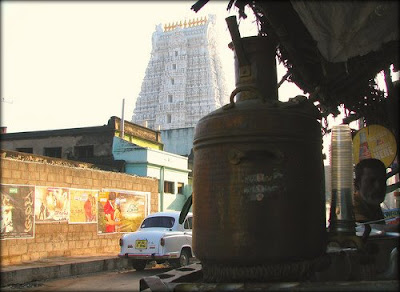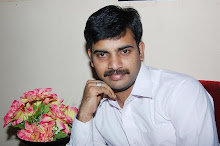
Lord Krishna
Being the birth place of Lord Krishna, Mathura is one of the most sacred destinations of India. As the legend goes, Mathura was founded in the Treta era by Shatrughna, the younger brother of Lord Rama and later was under the royalty of King Kamsa, the maternal uncle of Lord Krishna. According to Hindu mythology, Kamsa heard a divine prophecy saying that he would be killed by his sister Devki's eighth son Krisha.

Mathura SriKrishna Temple
Hence, he imprisoned Devki and her husband Vasudeva and kept on killing their children one after another. But when Lord Krishna was born, miraculously all guards went to sleep, prison gates opened and Vasudeva carried his son to Gokul crossing the wild river Yamuna in the mid night. The divine prophecy came true and Krishna killed tyrant Kamsa and ruled Mathura for a long time.
 Vrindavan is the place where Lord Krishna spent his childhood leaving a number of myths and legends of love and friendship behind.Pilgrims Find here SanctityStudded with number of ancient and modern temples, Mathura is the abode of God and divinity. Hinduism find here a new dimension which is the colour of love with which Lord Krishna wanted to bind this entire world.
Vrindavan is the place where Lord Krishna spent his childhood leaving a number of myths and legends of love and friendship behind.Pilgrims Find here SanctityStudded with number of ancient and modern temples, Mathura is the abode of God and divinity. Hinduism find here a new dimension which is the colour of love with which Lord Krishna wanted to bind this entire world.
 The mild sound of devotees taking the hundred and eight names of Lord Krishna all day long covers the entire ambience of Mathura. The immense belief of the pilgrims coming here from different parts of the world is something that give Mathura a well deserved wight and importance in the itinerary of Indian pilgrimages.
The mild sound of devotees taking the hundred and eight names of Lord Krishna all day long covers the entire ambience of Mathura. The immense belief of the pilgrims coming here from different parts of the world is something that give Mathura a well deserved wight and importance in the itinerary of Indian pilgrimages.
 SriKrishna Janmabhoomi
SriKrishna Janmabhoomi
(The Birth Place Of Lord Krishna)A vast temple complex situated in the heart of Mathura is one of the foremost places of Hindu veneration. It contains many smaller temples among which lies the age old prison of tyrant king Kamsa where Lord Krisha was born in order to save the universe from all evils. You have to be patient and maintain the long queue before entering into the narrow prison.
 Sri Balram Temple
Sri Balram Temple
The temple had been destroyed number of times in the ages of Mohammed Gazni, Sikander Lodi and Aurangzeb but had been restored every time. You have to undergo a security checking at the gate and we request you to co-operate with the guards. You will be asked to leave you mobile phone outside the premises.
 Vishram Ghat
Vishram Ghat
It is the most important bathing ghat in Mathura. Lord Krishna is said to have rested here after killing Kamsa, the tyrant king of Mathura. The 'Aarti' being offered in the morning and evening at the riverside is a visual treat to the eyes. It is believed that bathing in the Yamuna on the second day of Kartik is very meritorious which is known as Yama Dwitiya.
 ISKCON Temple
ISKCON Temple
Located within the Krishna-Baldev Temple premises, the temple wall is adorned with exquisite paintings and carvings depicting the life of Lord Krishna. Beautiful architecture, carved arches and immense spirituality make the place a divine destination in Vrindavan. Be prepared to listen to 'Hare Krishna' as everybody you will meet inside the temple premise will greet you with these two words.One more aspect of Mathura that fascinates is how people from different nationality, religion and race are getting painted with the colour of love of Shri Krishna.
 Mathura is truly a global city where people from various corners of the world come, lose themselves in the Krishna-divinity and start a new life in the ancient and narrow lanes of Mathura. You will find hundreds of ISKON (International Society of Krishna Consciousness) followers from foreign lands enchanting Sanskrit mantra effortlessly.When Divinity Mingles With FestivityThe quiet and ancient cities Mathura and Vrindavan come alive as the month of September arrives and devotees celebrate the birth of Lord Krish which is popularly know as Janmasthami with much enthusiasm and gaiety. Devout from various parts of the world come here to attend and participate in this grand celebration.
Mathura is truly a global city where people from various corners of the world come, lose themselves in the Krishna-divinity and start a new life in the ancient and narrow lanes of Mathura. You will find hundreds of ISKON (International Society of Krishna Consciousness) followers from foreign lands enchanting Sanskrit mantra effortlessly.When Divinity Mingles With FestivityThe quiet and ancient cities Mathura and Vrindavan come alive as the month of September arrives and devotees celebrate the birth of Lord Krish which is popularly know as Janmasthami with much enthusiasm and gaiety. Devout from various parts of the world come here to attend and participate in this grand celebration.
 Govindaji Temple
Govindaji Temple
Built in 1590, this ancient temple of Vrindavan has a number of fascinating stories to tell. The original Govindaji Deity was removed from this temple and kept in Jaipur when Mughal Emperor Aurangzeb tried to destroy it. This magnificent temple houses a spectacular marble altar adorned with gold and silver and hold the idols of Govindaji in the middle, Lord Chaitanya to His left and Lord Nityananda to His right.
 Sri Govindaji
Sri GovindajiA sculptured lotus flower weighing several tons decorates the main hall of the temple and demands a careful look from your side.Brij Ki Holi is a festival of colours that leaves an ever lasting memory in the minds of the its participants and people don't even mind when their clothes and hair get colured with different shades of gulal (powdered colour). Plan your Mathura-Vrindavan tour at the time of Holi to savour a new colur of life.
 Madan Mohana Temple, Radha-Ballava Temple, Radha-Damodara Temple and Radha-Gopinath Temple are some of famous temples of Vrindavan which you should not miss while you are in Vrindavan. Tourist InformationMathura and Vrindavan are hot in summer and best in winter. But if you plan your trip at the time of Janmashtami in Sepetember and Holi in March, you can discover the cities the most.By AirThe nearest airport is Agra which is 66 km away and is well connected to Delhi, Khajuraho and Varanasi by regular flights by Indian Airlines and other private airline services.
Madan Mohana Temple, Radha-Ballava Temple, Radha-Damodara Temple and Radha-Gopinath Temple are some of famous temples of Vrindavan which you should not miss while you are in Vrindavan. Tourist InformationMathura and Vrindavan are hot in summer and best in winter. But if you plan your trip at the time of Janmashtami in Sepetember and Holi in March, you can discover the cities the most.By AirThe nearest airport is Agra which is 66 km away and is well connected to Delhi, Khajuraho and Varanasi by regular flights by Indian Airlines and other private airline services.
 By RailMathura Junction is well connected to Delhi by numerous trains including the Punjab Mail and Taj Express, to Mumbai by the August Kranti and Mumbai Rajdhani and to Kolkata by the Toofan Express. The Lucknow-Agra Express also finds Mathura in its route.By RoadMathura and Vrindavan are well connected with Agra, Delhi, Bharatpur, Alwar and Lucknow by well maintained road.Local TransportBuses run by the UPSRTDC taxis (can be hired from the taxi stand opposite the District Hospital), auto-rickshaws, cycle-rickshaws and tongas (rates negotiable), are the main means of transportation.
By RailMathura Junction is well connected to Delhi by numerous trains including the Punjab Mail and Taj Express, to Mumbai by the August Kranti and Mumbai Rajdhani and to Kolkata by the Toofan Express. The Lucknow-Agra Express also finds Mathura in its route.By RoadMathura and Vrindavan are well connected with Agra, Delhi, Bharatpur, Alwar and Lucknow by well maintained road.Local TransportBuses run by the UPSRTDC taxis (can be hired from the taxi stand opposite the District Hospital), auto-rickshaws, cycle-rickshaws and tongas (rates negotiable), are the main means of transportation.
.jpg) The earliest of the records belong to the year 1235 A.D when the Chola King, Raja Raja III was ruling the place. In the year 1239 A.D the queen of Viranarasinga of Yadavaraya made a gift for decoration of the chariot and carrying necessary repairs.
The earliest of the records belong to the year 1235 A.D when the Chola King, Raja Raja III was ruling the place. In the year 1239 A.D the queen of Viranarasinga of Yadavaraya made a gift for decoration of the chariot and carrying necessary repairs.  The temple came in for greater importance in 1506 A.D. during the rule of Saluva Dynasty of Vijayanagar and from then onwards different rulers in a different way developed the temple.
The temple came in for greater importance in 1506 A.D. during the rule of Saluva Dynasty of Vijayanagar and from then onwards different rulers in a different way developed the temple. .jpg) The emergence of Govindaraj Swamy has already been discussed in the temple history of Lord Venkateswara at Tirumala.
The emergence of Govindaraj Swamy has already been discussed in the temple history of Lord Venkateswara at Tirumala. .jpg) It is very interesting to note that this is the only idol in India for which no "Abhisekham" pooja is performed since the day of its consecretion as it was made of clay.
It is very interesting to note that this is the only idol in India for which no "Abhisekham" pooja is performed since the day of its consecretion as it was made of clay. 


















































